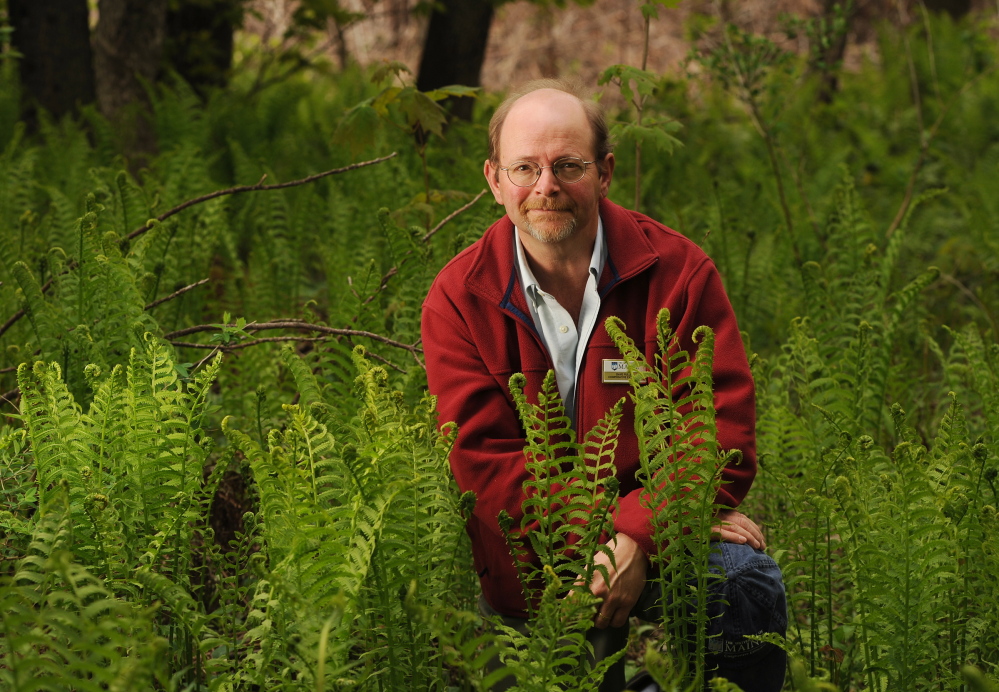Agricultural and non-timber forest products professional David Fuller, in the Franklin County University of Maine Extension office in Farmington, is UMaine’s resident expert on fiddleheads, aka the early spring growth of the ostrich fern. With the end of the season fast approaching, we called Fuller to chat about fiddleheads.
CLAIM TO FAME: His fact sheet on fiddleheads (http://umaine.edu/publications/4198e/) has been viewed 48,100 times in the last year.
POSITIVE IDENTIFICATION: First and foremost, Fuller teaches people how to identify fiddleheads. The ostrich fern has three core characteristics: the lower stem is smooth, not hairy or furry; in the inside of the stem is a deep, U-shaped curve; and a brown parchmentlike paper covers the top of the fiddlehead. “I tell folks you don’t really need to know the other ferns,” Fuller said. “You just need to know that none of the other ferns have those three things.” (Source ran a photograph of the wrong fern with a fiddlehead story last week. We’re sorry. And embarrassed.)
WHAT DID THAT MISERABLE WINTER DO TO OUR FIDDLEHEADS? “It slowed them by a week to 10 days. For the Maine Fiddlehead Festival (May 3) we had to scratch to get them.”
WAYS IN WHICH FIDDLEHEADS ARE LIKE WILBUR THE PIG: Asked to describe the unique fiddlehead color, Fuller pauses. “A fresh or bright green. It’s really radiant, you know?”
HOW HE PREPARES THEM: Boils them for 15 minutes. “Salt and pepper and butter.”
BUT BOILED VEGETABLES ARE SO DEPRESSING: “The folks that are cooking them for restaurants tell us, ‘You are killing the fiddlehead!’ But we argue that food safety comes first. You shouldn’t be eating al dente fiddleheads.”
WHY NOT?: Fiddleheads grow in moist places, near rivers that might be carrying less than desirable bacteria. The Centers for Disease Control and Prevention has established cooking times, 12 minutes of steaming or 15 minutes of boiling, for safety. But Fuller may figure out a reprieve for fans of the non-soggy green; he and other state scientists are investigating if fiddleheads can be cooked less and still be safe to eat.
DOES THAT EXPLAIN THAT SIGN ON ROUTE 1 FOR “CLEAN FIDDLEHEADS”? No. “It should say cleaned,” Fuller said. Meaning the parchment that covers the tops of them has been removed. “That round patch on the top is a real pain to get off.”
ADVISE US ON THAT: “Some people will take them outside on a windy day and drop them from a not high distance, say a foot and a half.” Or use a fan. In the absence of wind, artificial or otherwise, rub them between your fingers.
HOW FIDDLEHEADS BECAME HIS THING: As a specialist in non-timber forest products, Fuller also knows his maple syrup, birch bark and spruce gum and, of course, the wreath industry. And he knew something of fiddleheads, but eight years ago, decided to specialize. “I said to myself, there hasn’t been a whole lot done on fiddleheads.” His first project was a three-year study on sustainability. Can a fiddlehead plant, or “crown” bounce back if someone removes every individual fiddlehead in a crown? The findings: no. So take a few, maybe come back for a few more later as the plant unfurls, but don’t be greedy.
DO FRIENDS GIVE HIM FIDDLEHEAD MEMORABILIA? “No, and I am deeply hurt.” But in his office, he has a poster from a past Fiddlehead Festival and a dry mount of scientific plate of specimens gathered in 1924. He did have a jar of pickled fiddleheads, but they have gone missing.
Send questions/comments to the editors.




Success. Please wait for the page to reload. If the page does not reload within 5 seconds, please refresh the page.
Enter your email and password to access comments.
Hi, to comment on stories you must . This profile is in addition to your subscription and website login.
Already have a commenting profile? .
Invalid username/password.
Please check your email to confirm and complete your registration.
Only subscribers are eligible to post comments. Please subscribe or login first for digital access. Here’s why.
Use the form below to reset your password. When you've submitted your account email, we will send an email with a reset code.